Abstract
Novichok-like or fourth-generation agents (FGAs) are chemical warfare agents (CWAs) which have been gaining attention since their use in assassination attempts on Sergei Skripal and Alexei Navalny. Due to their physicochemical properties, these substances are difficult to detect by implemented technologies, resulting in massive response efforts if their occurrence is suspected in a civilian environment. In this work, an approach is presented that uses handheld forensic light sources to visually detect surfaces contaminated with Novichok. More than 100 different wavelength combinations were applied to seven substances chosen to represent the newly listed schedule 1 subgroups in the Annex on Chemicals of the Chemical Weapons Convention. One waveband was identified as promising, which allowed the optical detection of all tested substances. Several surfaces, which could be affected in case of a possible attack using novichok-like nerve agents, were also successfully evaluated. The proposed procedure could be implemented for CBRN responders and security agencies to significantly reduce response efforts, thereby diminishing the overall threat posed by this group of chemicals (FGAs). This procedure was also extended to carbamates and CWAs.
1. Introduction
The development and existence of Novichok agents (Russian for newcomer) have been an ongoing discussion since the first publication of their existence in 1995 by Mirzayanov [1]. These substances again gained some attention from 2007–2010 [2,3,4] in the scientific community. More than 100 different substances have been referred to the Novichok category. The only undisputed information is that the FGAs function by inhibiting the enzyme acetylcholinesterase, therefore classifying them as nerve agents. However, with the first documented use in 2018 in Salisbury to target Sergei Skripal, these agents became famous, also in the mainstream media [5]. However, accurate, reliable data on Novichoks is still lacking, posing challenges for incident responses [6].
Various synonyms are used for Novichoks, like Fourth-Generation Agents (FGAs) or A-Agents. Some of these agents are now subject to the CWC (Chemical Weapons Convention) [7]: After two decisions [8,9] of the Conference of State Parties in November 2019, the Director-General of the OPCW (Organisation for the Prohibition of Chemical Weapons) notified all State Parties and the Depository of the approval by the Conference regarding the changes to the Annex on Chemicals in December 2019. Pursuant to subparagraph 5(g) of Article XV of the CWC, these changes to the Annex on Chemicals entered into force 180 days after the date of this notification by the Director-General, that was, on 7 June 2020. In addition, the Technical Secretariat of the OPCW sent out a note with the consolidated text of the changes to Schedule 1 of the Annex on chemicals to the Chemical Weapons Convention [10].
Since the Skripal incident, a Novichok agent again was used against the Russian dissident Alexei Navalny. The results of the analysis of biomedical samples conducted by the OPCW-designated laboratories demonstrated that Mr. Navalny was exposed to a toxic chemical with similar structural characteristics as the newly listed agents belonging to schedules 1.A.14 and 1.A.15 of the CWC [11].
Originally chemical warfare agents (CWAs) were developed to change the course of the war and bring momentum to the stalemate in trench warfare during WWI. However, already before the emergence of Novichok-like agents, CWAs had been used as assassination tools (also VX) [12,13,14,15]. Thereby CBRN incidents emerge as a new challenge for forensic applications. Some programs have been established to address forensic issues in the CBRN environment, aiming to increase either forensic awareness for CBRN responders or CBRN awareness for forensic specialists [16,17,18,19,20].
The FGAs are especially tricky because of their low vapor pressure and their high boiling points; gas phase detection is very difficult [21]. Contrary to G-agents (e.g., Tabun, Sarin, or Soman) which primarily function via inhalation, FGAs and also VX are primarily toxic when contaminating the skin, even in minimal doses (milligrams) [22]. However, CWA detection is mainly based on gas phase detection.
Several manufacturers of CWA detectors are already training to adopt their instruments for FGA detection. These approaches mainly focus on heating up samples so that the target is transferred in a gas/vapor phase and becomes detectable. This, however, has to be done by extracting the area/surface of interest bit by bit. Another approach would be enzyme-based detection of such agents using their AChE-blocking characteristics [23].
Several more sophisticated technologies like mass spectrometry, UV-, IR- or Raman-spectroscopy could be used to analyze and confirm the presence of FGAs. However, they are of limited use to Responders, as they do not allow direct identification of possible contamination spots due to sensitivity limitations of handheld equipment and therefore require a sampling step. Another major issue is the availability of spectroscopic information on FGAs. Even though FGAs have been added to the CWC, so far only theoretically simulated IR- and Raman-spectra are available in the literature [24,25].
The Salisbury incident, where Sergei Skripal was targeted, shows the impact of conventional detection. Since gas detectors were not applicable other means were implemented, resulting in a much higher workload and time demand. Countless working hours in protective equipment had to be performed. Enzyme-based detection and decontamination approaches were developed and implemented over a period of three months [26,27]. Since the agents were released in a civilian environment, most reliability had to be achieved before releasing the affected areas to the public again.
The use of FGAs in the last five years has demonstrated that certain actors have no constraints against the use of CWAs in public areas. Therefore, the need arises for quick, reliable, and non-invasive ways to detect FGAs in an urban environment.
Portable forensic light sources have been in use for decades to assess biological traces at crime scenes [28]. Developments in LED and laser technology have increased sensitivity, selectivity, portability, and wavelength range accessible in the field [29], thereby enabling its use for other traces, substances, or materials [30,31,32].
In this work, a technical approach is introduced to detect FGAs and surfaces contaminated with FGAs by using handheld forensic light sources, avoiding any cross-contamination compared to spraying systems. The tests were carried out with real FGA substances rather than simulants.
2. Materials and Methods
All experiments were carried out with live agents and were set up in a lab environment with multiple safety and security mechanisms. To reduce ambient light interference, all tests were performed in the dark, with windows shaded and lights turned off.
2.1. Instrumentation
Three different forensic light sources, all manufactured by foster + freeman, Evesham, UK, were used to test for FGA response:
- Crime-Lite X10 (CL-X10), LED-based forensic light source with ten different LEDs; up to three can be used at the same time (Table 1)
 Table 1. LED sources used in CL-X10 and CL-AUTO with emission wavelength and respective filters.
Table 1. LED sources used in CL-X10 and CL-AUTO with emission wavelength and respective filters. - Crime-Lite AUTO (CL-AUTO), a digital camera equipped with LEDs and filters with ten LEDs; up to two can be used at the same time (serial number 1245-22129, software version: 1.1.20.919–Table 1)
- Crime-Lite Laser, a laser-based forensic light source in blue and green (Table 2)
 Table 2. Light sources used in CL-Laser with emission wavelength and respective filters.
Table 2. Light sources used in CL-Laser with emission wavelength and respective filters.
CL-X10 was specifically chosen for the experiments because comparable forensic light sources can be used with only one wavelength at a time, whereas the CL-X10 allows the combination of up to three LEDs.
To observe the results from CL-X10 and CL-Laser, the digital camera of the CL-AUTO was used. The light sources were fixed orthogonal to the test surfaces at a distance of 30 cm.
2.2. Consumables
CWAs were provided by Spiez Laboratory (Spiez, Switzerland) and were of the highest available quality (92 to 98%) (Table 3). At least one representative was available for each new CWC schedule (1.A.13 to 1.A.16) [10], including A-230, A-232, and A-242. Nitrogen mustard (HN-3—schedule 1.A.06) was added to the studied substances as well as FGA similar unscheduled substances.

Table 3.
CWAs used for emission tests, and purity determined in-house by NMR and GC.
For interference tests, water, ethylene glycol, acetone, chlorobenzene, talcum powder, Sterisol® (ethanolic disinfectant in gel and liquid form; Sterisol, Vadstena, Sweeden), and decontamination solution (NaOH-PEG-DCN-solution) based on sodium hydroxide (NaOH) and polyethylene glycol (PEG) were used.
Surface materials were provided by Spiez Laboratory. Blue and white colored paper was used for the proof of concept tests. For bulk check tests, the substances were investigated directly in their respective glass storage vials. For the surface tests, the substances were transferred to anodized metal plates, a plastic light switch and plug housing, and blue nitrile gloves.
The substances (10 µL each) were deposited by pipette on the surface in the numerical order indicated in each respective Figure. The investigation was performed 15 min after the application of the first droplet, starting with white light conditions first and then moving on from narrow bandwidth (UV) to longer bandwidths (IR).
3. Results
3.1. Proof of Concept
First, experiments were carried out using white and blue papers as clear and dark surfaces. One droplet of 10 µL of each sample was deposited on the respective surface, which was then exposed to all available light conditions (175 wavebands originating from ten singular LED lamps and combinations of up to three at the same time) in a dark room. The following effects were recognized while observing each waveband with its respective filter (Table 1 and Table 2):
- No light—no visibility of the target surface due to filter cut-off and/or dark conditions
- No interaction—no change in observation between normal ambient light and LED exposure
- Illumination—the respective substance is observed in a different color contrast than under ambient light conditions
- Excitation—fluorescence effects as a result of LED exposure
For wavebands investigated by combining two or more LEDs, the filter intended for the highest used waveband was always chosen.
The results of the “proof of concept” tests are displayed in Figure 1. The first line shows a normal white light picture of the droplets. They could be seen by the naked eye. However, there is no way to discern them from water or other colorless liquid substances. The second line shows the interaction of the substances with blue light (445 nm peak emission). HN-3, substances 2 and 3 show excitation behavior, and all other investigated substances show illumination behavior. This condition works for blue and white paper surfaces. When adding UV (365 nm peak emission) to the blue light, displayed in line 3, the background interaction of the white paper surface reduces the contrast considerably, making it close to impossible to discern the target material from the background. For the blue paper surface, the addition of UV light has a negative effect on the visibility of the contaminated areas.
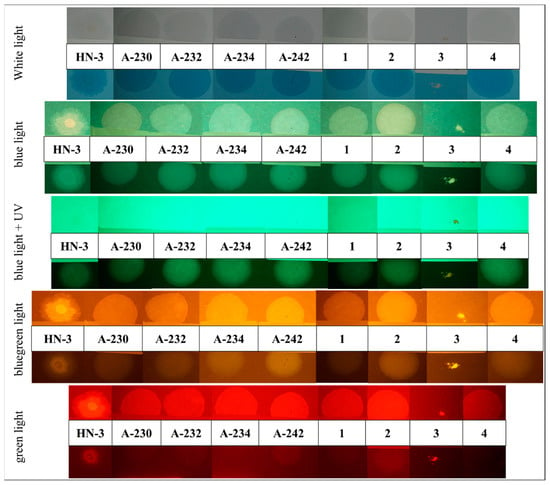
Figure 1.
General light exposure tests, substances (10 µL droplets) applied to white (top) and blue paper (bottom), selected light settings illuminated with CL-X10, emission and filter conditions according to Table 1, pictures taken by CL-AUTO.
Bluegreen light (475 nm peak emission) again shows excitation-like interaction for HN-3 and substance 3, as well as comparable contrast results for the white paper surface as shown for blue light. For the dark surface, however, A-230 and substance 1 were hardly visible, and A-232 and substance 4 were only slightly visible. With green light (520 nm peak emission) for the white paper surface, the same results were achieved as with blue-green light, whereas for the blue paper surface, only HN-3 and substance 3 were clearly visible.
In this setting, no useful optical effects have been observed for the other lamps/lamp combinations.
Besides HN-3, other CWAs (Tabun, Sarin, Soman, Cyclosarin, Sulphur Mustard, Lewisite, and VX) were also investigated but displayed no illumination behavior.
3.2. Bulk Tests
Derived from the Salisbury incident, information on the dangerousness of closed containers (like perfume bottles) is of particular interest. Therefore, this approach should be viable to investigate the interior of transparent housings without the need to open them. The selected substances were analyzed in their respective storage containers, in this case, narrow neck glass vials with volumes from 1 to 2 mL. The results are shown in Figure 2. Excitation behavior was observed for A-232 and substance 3, as well as substances 1 and A-242. The other substances showed illumination behavior with A-234 giving the least response.
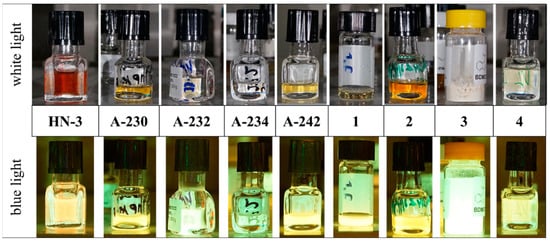
Figure 2.
Bulk tests with substances in transparent glass vials illuminated with CL-X10 in white light (top) and blue light, peak emission 445, filter GG495 (bottom), pictures taken by CL-AUTO.
3.3. Surface Tests
Two surfaces were considered to apply FGAs in our study. One is metal, such as that used in doorknobs, door handles, garden gates, etc., and the other is plastic, processed as light switches, power plugs, or toilet seats. All these examples are objects which need to be touched to utilize them, and in a household environment, this contact will primarily be by unprotected skin.
Anodized metal plates, as well as light switches and plug sockets, were used as target materials. Again, single droplets (10 µL) were applied. To investigate cross-sensitivity to other liquid substances, some laboratory solvents, disinfectants, and some which are likely to occur in a household environment, were added. No excitation or illumination behavior was observed for those substances. The results are displayed in Figure 3. Again, the blue light (445 nm peak emission) yielded the best results from all applied wavebands. All investigated FGA substances showed excitation or illumination performance, while none of the other liquids did. Long bandwidth wavebands (orange, red, and IR) showed improved depth perception for the three-dimensional droplet shapes. These wavebands can be used to discover liquids or stains present on a substrate as long as they show edges at the surface-droplet boundary. This phenomenon is already widely used (e.g., for glasses and goggles for skiing during foggy conditions) [33]. All other wavebands yielded less useful results.
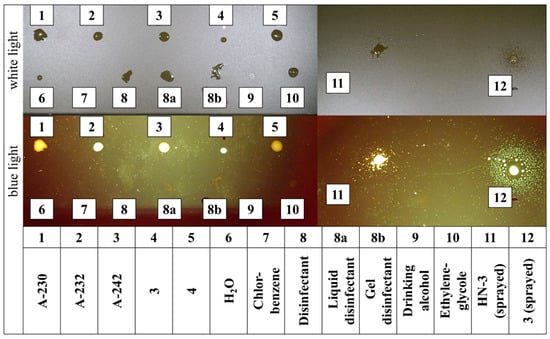
Figure 3.
Anodized metal plates with applied droplets (10 µL) illuminated in white light (top) and blue light, peak emission 445, filter GG495 (bottom) with CL-X10, pictures taken by CL-AUTO.
The same procedure was performed with plastic material originating from a light switch socket and a plug socket. On these surfaces, similar results were obtained (Figure 4). All FGAs were observed with the blue LED waveband. The substrate ethylene glycol showed a different performance, with a darkened spot in the middle of the droplet and a light ring encircling the droplet boundary. The water droplet on the plug socket was also observed as a dark spot in blue light. Even though two interferences showed a detection result with the approach, both were distinctively different from the FGAs and are easily distinguishable for well-trained and experienced people.
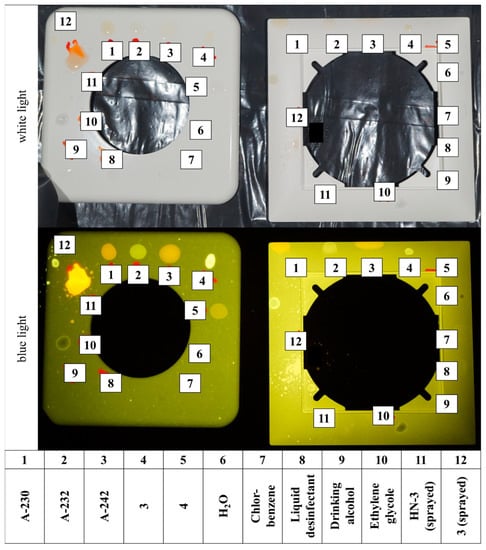
Figure 4.
Light switch sockets (left) and plug sockets (right) with applied droplets (10 µL) illuminated in white light (top) and blue light, peak emission 445, filter GG495 (bottom) with CL-X10, pictures taken by CL-AUTO.
To further increase confidence in the approach, some tests were performed to evaluate the assessment of illumination and excitation effects without knowing which substances have been applied. For these tests, besides the metal plate, a nitrile glove as a new surface as well as two new substances were investigated: NaOH-PEG-DCN-solution and talcum powder. These substances were introduced to further challenge the assessment by introducing unknown effects for the evaluator. The nitrile glove was chosen as a target to examine possible applications to check for cross-contamination of hot-zone personnel. Since blue light emission has been showing the most promising results, a blue glove was utilized to inquire about potential interfering effects. Investigations were performed under the same conditions as the previous experiments, with one person applying the substances to the surfaces and another person using the light source and evaluating the results without knowing the applied substances and positions.
With the metal surface, the results previously obtained were confirmed. All FGA substances were visually detected, with A-234 giving only a weak signal. One substance was recognized as excited, however, with a different appearance than previous observations. This substance was the NaOH-PEG-DCN-solution which gave a response appearing as a dot of the droplet center and a line encircling the droplet boundary. Comparing these results to the plastic surface observations, there is a similarity to the ethylene glycol response. Still, it is easily distinguishable from the FGA spots. Results are displayed in Figure 5.
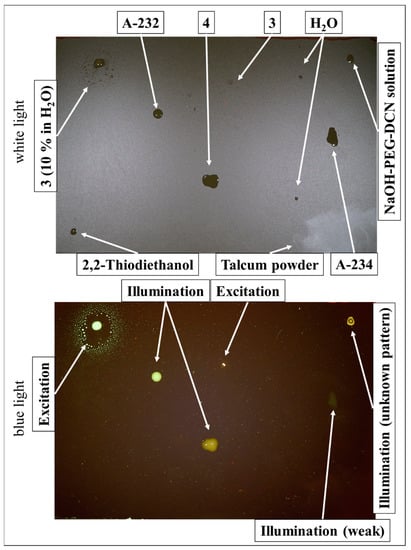
Figure 5.
Contaminated anodized metal surface with applied droplets (10 µL) illuminated in white light (top) and blue light, peak emission 445, filter GG495 (bottom) with CL-X10, substances used for contamination were unknown to the operator performing the detection analysis, pictures taken by CL-AUTO.
This test was again performed with a nitrile glove as substrate. The blue color of the glove was chosen especially to investigate any blue light absorption phenomena. This time only two out of four deposited FGAs and the NaOH-PEG-DCN-solution were detected. Substance 4 and A-234 were not showing any excitation or illumination behavior at all. Both these substances, which were clearly observable on the other substrates, could not be detected on the blue nitrile glove. Results are displayed in Figure 6.
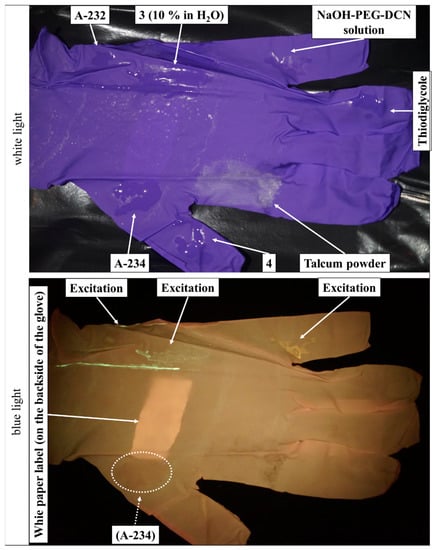
Figure 6.
Contaminated nitrile glove illuminated in white light (top) and blue light, peak emission 445, filter GG495 (bottom) with CL-X10, substances used for contamination were unknown to the operator performing the detection analysis, A-234 (dotted line) was not recognized by the operator, pictures taken by CL-AUTO.
3.4. Excitation by Laser Sources
Currently, only two emission sources (blue and green) are available on a laser basis which were both investigated. The blue light laser (447 nm peak emission) gives a similar response to blue LED emission, whereas the green laser (520 nm peak emission) is not suitable for most substances. All results achieved by the blue LED could be replicated with a blue CL-Laser.
4. Discussion
This approach is not intended to be a stand-alone identification procedure but an assistance method for on-site detection, enabling a fast visualization of possible contaminated spots of FGAs with an adequate confidence level. Instead of examining suspect surfaces square by square involving work-intensive and time-demanding sampling and analysis in CBRN-protective equipment, this approach could be used to screen areas easily and rapidly. Such screening could also be utilized by security personnel to scan surfaces prior to the arrival of the potentially targeted subject as a preventive method, similar to a taster for ingestion.
In contrast to conventional CBRN detection approaches using gas monitors, this approach is not limited by the compound’s chemical vapor pressure and, therefore, is also not limited to the ambient temperature. It can be used as fast as a torch light, covering large surface areas in little time. Ambient light conditions, however, are a limiting factor. Under direct sunlight or general bright conditions, the illumination and excitation effects will not be observable. For now, the approach is limited to scenarios with adjustable light conditions (indoors, using tents or other means to shade) or dark environment settings (outdoors, during twilight, or nighttime).
4.1. Proof of Concept
Based on our results, no stringent explanation for the observed light interaction behavior could be found. The best results were achieved under blue light conditions.
All compounds consist of at least one nitrogen atom, which possibly contributes free electron pairs, but the bonding partners are quite different. All substances other than HN-3 contain at least a moiety that could introduce auxochromic effects. For substance 3, the carbamate structure is based on an aromatic heterocyclic part. The P(O)N= arrangement is present in the organophosphate compounds. Nevertheless, we observed that HN-3 and substance 3 showed the best response of all investigated substances. Despite the high purity of the substances used, our tests cannot exclude that one or more impurities present are responsible for the effects. To further investigate the interaction mechanism, the specific emission wavelengths have to be determined.
4.2. Bulk Tests
As long as the emitted light can enter and exit a transparent container without being absorbed or reflected, the methodology can be applied. Thereby, a fast screening of such suspected containers can be achieved to visually identify the relevant flasks or vials which show illumination or excitation effects.
In the Skripal case, the applied Novichok agent was hidden in a perfume bottle, which was discarded by the culprits. The bottle, which was later found by an unrelated civilian, caused the only case-related casualty. In this case, the container was found outside the perimeter. However, using this approach to screen such transparent containers at a crime scene would easily indicate them as possible threats without having to open them.
4.3. Surface Tests
As already addressed in the introduction for FGAs, the hazard of direct contact or ingestion is more relevant than inhalation. Therefore, the attack paths most likely will be objects which may be touched or ingested by the victim. Substances could possibly be deposited on items like door handles, light switches, car handles, or garden gates. If FGAs are deposited at surfaces with hostile intent, the substances are expected to be applied in a matter of hours prior. Because the detection was performed only minutes after depositing the target substances at the respective surface, as of now, no information is available to determine changes and or degradation over time. At this point, however, no major issues are expected due to the initially stated substance properties of the FGAs, such as high boiling points and low vapor pressures. The detection of some FGAs at exemplary surfaces has been successfully demonstrated. Even though other substances showed responses as well, the methodology allows fast identification of the relevant spots.
4.4. Cross-Contamination Check
During the intervention, the hands are prone to come in contact with contaminated surfaces (touch, shift, open, operate, etc.). To overcome cross-contamination, the gloves should be changed often. A procedure to check for chemical contamination, especially FGAs, would be a significant improvement for CBRN responders and HAZMAT personnel. With the demonstrated approach, the visual detection of such chemicals is feasible, thereby opening new engagement possibilities. It becomes possible to visualize the contaminated surfaces and thus avoid any cross-contamination. Nevertheless, the methodology must be applied with care, as some surfaces inhibit all visualization (e.g., absorbing surfaces such as wood or carpet). This effect will be investigated in more detail in future experiments involving hyperspectral imaging.
4.5. Safety Equipment
When working with strong light sources depending on the peak emission, wavelength filter goggles should be worn to enable detectability by removing interfering fluorescence as well as a safety measure for eye protection. For laser sources, certified safety goggles and training are mandatory. In a CBRN environment, these safety procedures need to be implemented together with CBRN protective equipment (respirator mask, protective suit, etc.). Certified safety goggles compatible with some full-face respirator masks are already available.
4.6. Forensic Exploitation
Contrary to other colorimetric optical detection approaches based on the acetylcholine esterase enzyme inhibition properties, no liquid additives need to be used. Therefore, no change, hampering, or destruction of forensic traces or collectible exploitable material is anticipated.
This approach could also be used to assess if forensic traces present in a CBRN incident are contaminated by hazardous materials. Procedures to handle such traces are still scarce and limited to forensic laboratories with sufficient safety protocols to also handle CBRN materials [34]. For crime scenes in CBRN-hazardous-environment, so far, viable screening procedures exist only for radiological hazards. In those cases, the detection technologies enable to distinguish between contaminated and not contaminated items and/or surfaces, whereas no similar procedures are available for cases involving chemical or biological contamination hazards. To address safety protocols for chemical and biological contamination, decontamination procedures need to be applied. The use of most decontaminants will lead to change, hampering, or even destruction of available forensic traces, therefore negatively affecting the exploitation results [35]. For FGAs, the presented approach could be used as an indicator if the trace of interest is contaminated or not, thereby providing a quick screening option to prioritize scene exploitation and implementing safety procedures for safe handling.
In a crime scene environment, forensic light sources are already used to illuminate forensic traces. Therefore, some interferences in terms of body fluids (e.g., blood, semen) are to be expected. However, also the spray pattern of the investigated substance needs to be considered as an additional indicator. If, like in the Skripal case, a spray bottle is used to deploy the FGA, the spray pattern will be similar to the application of substance 3 in Figure 5 and, therefore, most likely be discernable from biological traces. Thereby, we demonstrate the utility of the approach to search for possible spots of relevant chemicals at the crime scene.
5. Conclusions
In this work, an optical detection procedure for FGAs is presented. Based on handheld forensic light sources, surface contamination with FGAs could be visualized. For the first time, simple and fast on-scene management for suspected FGA incidents is enabled, and CBRN consequence management can be expedited. By using this procedure, surfaces can be screened rapidly to visualize the contamination by a FGA. Instead of investigating the whole area, only particular parts of surfaces showing a light response need to be examined by CBRN identification and sampling processes. Forensic traces without detection response could be handled and exploited with reduced or even without CBRN safety precautions. Thereby operating time in a contaminated environment wearing full protective equipment could be reduced significantly. The authors emphasize the fact that such an application requires well-trained and experienced personnel.
Further research is planned, focusing on analyzing the full spectral response of FGAs and other CWAs when applying different wavebands to further investigate and understand the mechanism behind these findings. Additional work is also required to investigate influences on the detectability of FGAs when more time (several hours) elapses between deposition and detection. This approach may also be applicable to other materials such as pharmaceutical-based agents (PBAs) or other Central Nervous System Acting Agents problematic for CBRN or HAZMAT detection due to similar properties, such as low vapor pressure or even biological substances.
Author Contributions
Conceptualization, G.B., A.W. and B.M.; methodology, G.B., A.W. and B.M.; investigation, A.W. and B.M.; resources, G.B. and C.C.; writing—original draft preparation, G.B. and G.P.; writing—review and editing, G.B., G.P. and C.C.; visualization, G.B.; supervision, G.B. and C.C.; funding acquisition, G.B. and C.C. All authors have read and agreed to the published version of the manuscript.
Funding
The science: Research and development division of the Austrian federal ministry of defense provided financial support for open-access publication.
Institutional Review Board Statement
Not applicable.
Informed Consent Statement
Not applicable.
Data Availability Statement
Not applicable.
Acknowledgments
This work could not have been realized without the straightforward support and collaboration of Spiez Laboratory, Switzerland, the NBC-EOD center of competence, Switzerland, the CBRN-Defense Centre, Austrian Armed Forces, and the science, research and development division, Austrian federal ministry of defense and the procurement division, Austrian federal ministry of defense.
Conflicts of Interest
The authors declare no conflict of interest.
References
- Mirzayanov, V.S. Dismantling the Soviet/Russian chemical weapons complex: An insider’s view. Chem. Weapons Disarm. Russ. Probl. Prospect. 1995, 21–33. [Google Scholar]
- Antonijevic, B.; Stojiljkovic, M.P. Unequal efficacy of pyridinium oximes in acute organophosphate poisoning. Clin. Med. Res. 2007, 5, 71–82. [Google Scholar] [CrossRef] [PubMed]
- Tucker, J.B. The future of chemical weapons. New Atlantis 2009, 26, 3–29. [Google Scholar]
- Porteous, H. State Secrets: An Insider’s Chronicle of the Russian Chemical Weapons Program, by S. Vil Mirzayanov. J. Slav. Mil. Stud. 2010, 23, 537–539. [Google Scholar] [CrossRef]
- Stewart, J. The Grey Orchestra: Elastic Communications and the UK’s Response to Salisbury. RUSI J. 2022, 167, 38–49. [Google Scholar] [CrossRef]
- Noga, M.; Jurowski, K. What do we currently know about Novichoks? The state of the art. Arch. Toxicol. 2022, 97, 651–661. [Google Scholar] [CrossRef]
- OPCW. Convention on the Prohibition of the Development, Production, Stockpiling and Use of Chemical Weapons and on Their Destruction; OPCW: The Hague, The Netherlands, 1997. [Google Scholar]
- C-24/DEC.4; Decision; Technical Change to Schedule 1(a) of the Annex on Chemicals to the Chemical Weapons Convention. OPCW: The Hague, The Netherlands, 2019.
- C-24/DEC.5; Decision; Changes to Schedule 1 of the Annex on Chemicals to the Chemical Weapons Convention. OPCW: The Hague, The Netherlands, 2019.
- S/1820/2019; Note by the Technical Secretariat; Consolidated Text of Adopted Changes to Schedule 1 of the Annex on Chemicals to the Chemical Weapons Convention. OPCW: The Hague, The Netherlands, 2019.
- S/1906/2020; Note by the Technical Secretariat; Summary of the Report on Activities Carried Out in Support of a Request for Technical Assistance by Germany (Technical Assistance Visit—TAV/01/20). OPCW: The Hague, The Netherlands, 2020.
- Nakagawa, T.; Tu, A.T. Murders with VX: Aum shinrikyo in Japan and the assassination of Kim jong-nam in Malaysia. Forensic Toxicol. 2018, 36, 542–544. [Google Scholar] [CrossRef]
- Tu, A.T. The use of VX as a terrorist agent: Action by Aum Shinrikyo of Japan and the death of Kim Jong-Nam in Malaysia: Four case studies. Glob. Secur. Health Sci. Policy 2020, 5, 48–56. [Google Scholar] [CrossRef]
- Lee, E.J. The Political Assassination of Kim Jong Nam: A Comparative Analysis of US and South Korean News Coverage. Southwest. Mass Commun. J. 2018, 33. [Google Scholar]
- Kim, H.K. State Terrorism as a Mechanism for Acts of Violence against Individuals: Case Studies of Kim Jong-Nam, Skripal and Khashoggi Assassinations. J. East Asia Int. Law 2021, 14, 55–78. [Google Scholar] [CrossRef]
- Vahlberg, C. Improved CBRN preparedness and response through teamwork and knowledge sharing. Biosecurity Bioterrorism Biodefense Strategy Pract. Sci. 2013, 11, S45. [Google Scholar] [CrossRef] [PubMed]
- Nys, B.; Kummer, N.; de Bruyn, P.; Blok, J. Increasing Forensic Awareness of CBRNE Responders and CBRNE Awareness of Forensic Experts: A Pan-European Challenge. In Enhancing CBRNE Safety & Security: Proceedings of the SICC 2017 Conference: Science as the First Countermeasure for CBRNE and Cyber Threats; Springer: Berlin/Heidelberg, Germany, 2018; pp. 333–339. [Google Scholar]
- Malizia, A.; D’Arienzo, M. Enhancing CBRNE Safety & Security: Proceedings of the SICC 2017 Conference; Springer: Berlin/Heidelberg, Germany, 2018. [Google Scholar]
- Kummer, N.; Augustyns, B.; Van Rompaey, D.; De Meulenaere, K. Forensic investigation of incidents involving chemical threat agent: Presentation of the operating procedure developed in Belgium for a field-exercise. Forensic Sci. Int. 2019, 299, 180–186. [Google Scholar] [CrossRef] [PubMed]
- Kolencik, M. Crime Scene Investigation in a CBRN Context; ISEM Institute: Žilina, Slovakia, 2021. [Google Scholar] [CrossRef]
- Kloske, M.; Witkiewicz, Z. Novichoks—The A group of organophosphorus chemical warfare agents. Chemosphere 2019, 221, 672–682. [Google Scholar] [CrossRef]
- Vale, J.A.; Marrs, T.C.; Maynard, R.L. Novichok: A murderous nerve agent attack in the UK. Clin. Toxicol. 2018, 56, 1093–1097. [Google Scholar] [CrossRef]
- Silva, V.B.; Santos, Y.H.; Hellinger, R.; Mansour, S.; Delaune, A.; Legros, J.; Zinoviev, S.; Nogueira, E.S.; Orth, E.S. Organophosphorus chemical security from a peaceful perspective: Sustainable practices in its synthesis, decontamination and detection. Green Chem. 2022, 24, 585–613. [Google Scholar] [CrossRef]
- Bhakhoa, H.; Rhyman, L.; Ramasami, P. Theoretical study of the molecular aspect of the suspected novichok agent A234 of the Skripal poisoning. R. Soc. Open Sci. 2019, 6, 181831. [Google Scholar] [CrossRef] [PubMed]
- Kim, H.; Yoon, U.H.; Ryu, T.I.; Jeong, H.J.; Kim, S.i.; Park, J.; Kye, Y.S.; Hwang, S.-R.; Kim, D.; cho, Y.; et al. Calculation of the infrared spectra of organophosphorus compounds and prediction of new types of nerve agents. N. J. Chem. 2022, 46, 8653–8661. [Google Scholar] [CrossRef]
- Harvey, S.P.; McMahon, L.R.; Berg, F.J. Hydrolysis and enzymatic degradation of Novichok nerve agents. Heliyon 2020, 6, e03153. [Google Scholar] [CrossRef]
- Jacquet, P.; Rémy, B.; Bross, R.P.T.; van Grol, M.; Gaucher, F.; Chabrière, E.; de Koning, M.C.; Daudé, D. Enzymatic decontamination of G-type, V-type and Novichok nerve agents. Int. J. Mol. Sci. 2021, 22, 8152. [Google Scholar] [CrossRef]
- Chuena, L.W.; Eea, K.B. Forensic light sources for detection of biological evidences in crime scene investigation: A review. Malays. J. Forensic. Sci. 2010, 1, 17–28. [Google Scholar]
- Finnis, J.; Davidson, G.; Fraser, I.; Murphy, C.; Hargreaves, C.; Stevenson, N.; Doole, S.; Rogers, C. Illuminating the benefits and limitations of forensic light sources. Sci. Justice 2023, 63, 127–134. [Google Scholar] [CrossRef]
- Gonen, N.; Gilad, Y.; Ziv, D.; Rajs, N.; Finkelstein, N.S. Using an Alternate Light Source to Recover Sticker Marks from a Vehicle. J. Forensic Identif. 2022, 72, 313–319. [Google Scholar]
- Regterschot, R.; Enschede, S.H.; Eversdijk, M.M.; Lemmens, M.T.; Loci Forensics, B.V. A Study of Detecting Bones under Water Using a Forensic Light Source; University of Applied Sciences: Enschede, The Netherlands, 2021. [Google Scholar]
- Sheppard, K.; Fieldhouse, S.; Cassella, J. Simultaneous detection and image capture of biological evidence using a combined 360° camera system with single wavelength laser illumination. Sci. Justice 2019, 59, 75–82. [Google Scholar] [CrossRef]
- Glenn, L.E.; Zink, D.L.; Dupree, D.W. Vision and Performance Enhancement with Ski Goggle Tints; Pacific University: Forest Grove, OR, USA, 1996. [Google Scholar]
- Reutter, D.; Schutzer, S.E.; Craft, C.M.; Fletcher, J.; Fricke, F.L.; Holowachuk, S.A.; Johnson, R.C.; Keim, P.S.; Pearson, J.L.; Sibert, R.W. Planning for exercises of chemical, biological, radiological, and nuclear (CBRN) forensic capabilities. Biosecurity Bioterrorism Biodefense Strategy Pract. Sci. 2010, 8, 343–355. [Google Scholar] [CrossRef]
- Zuidberg, M.C.; van Woerkom, T.; de Bruin, K.G.; Stoel, R.D.; de Puit, M. Effects of CBRN decontaminants in common use by first responders on the recovery of latent fingerprints—Assessment of the loss of ridge detail on glass. J. Forensic Sci. 2014, 59, 61–69. [Google Scholar] [CrossRef]
Disclaimer/Publisher’s Note: The statements, opinions and data contained in all publications are solely those of the individual author(s) and contributor(s) and not of MDPI and/or the editor(s). MDPI and/or the editor(s) disclaim responsibility for any injury to people or property resulting from any ideas, methods, instructions or products referred to in the content. |
© 2023 by the authors. Licensee MDPI, Basel, Switzerland. This article is an open access article distributed under the terms and conditions of the Creative Commons Attribution (CC BY) license (https://creativecommons.org/licenses/by/4.0/).








